Trimble GL4XX Lazer Level System User Manual 061331 01 GL4X2 GB indd
Trimble Inc. Lazer Level System 061331 01 GL4X2 GB indd
Trimble >
Contents
- 1. GI422 User Manual
- 2. GL422 User Manual
GI422 User Manual
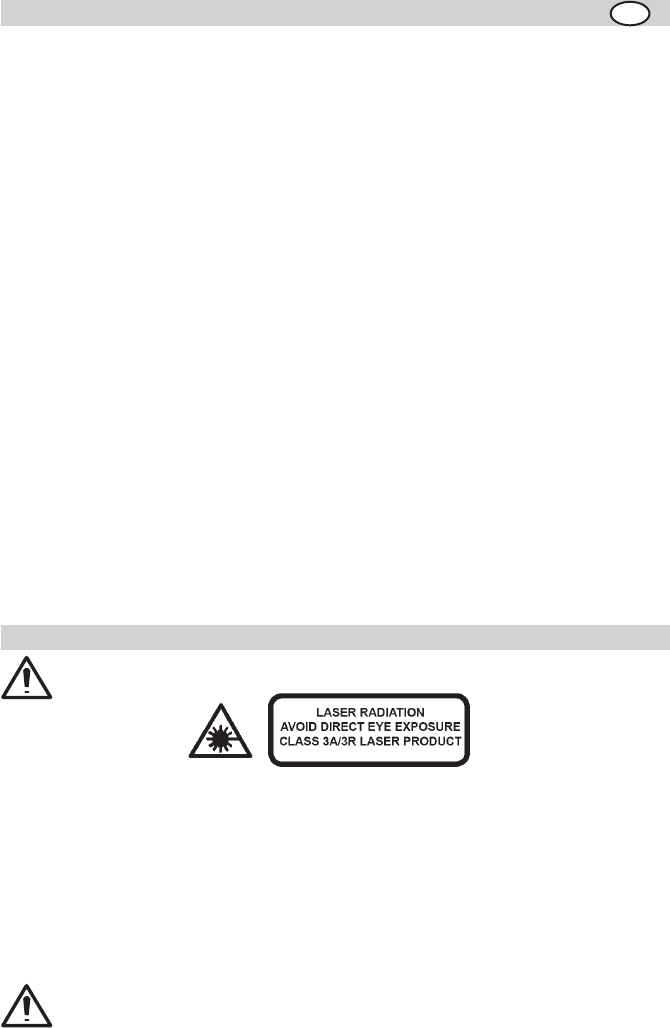
5
• Use of this product by people other than those trained on this product may result in exposure to hazardous
laser light.
• Do not remove warning labels from the unit.
• The GL422 is Class 3A/3R (< 5mW, 600 ... 680 nm). The GL412 laser is subject to Class 2
(< 3.4 mW, 600 ... 680 nm).
• Never look into the laser beam or direct it to the eyes of other people.
• Always operate the unit in a way that prevents the beam from getting into people‘s eyes.
If initial service is required, which results in the removal of the outer protective cover, removal must only be
performed by factory-trained personnel.
Caution: Use of other than the described user and calibration tools or other procedures may result
in exposure to hazardous laser light.
Caution: Unsafe operation may result if the product is used differently than described in this
operator‘s manual.
TABLE OF CONTENTS
FOR YOUR SAFETY 5
COMPONENTS 6
How to Use the Laser System 6
Powering the Laser 6
Laser Setup 7
Turning On/Off the Laser 7
Turning On/Off the Radio Remote Control 8
Matching the Remote Control with the Transmitter 8
Activating/Deactivating Standby Mode 8
Using the Manual Mode 8
Mask Mode 9
Y(⬔)- or X(y)-Axis Slope Mode 9
APPLICATIONS 10
General Construction 10
Determining the Height of Instrument (HI) 10
Using the Slope Mode 10
Establishing Vertical Alignment 11
CALIBRATION 11
Checking Calibration of the Y- and X-Axes 11
Checking Calibration of the Z-(vertical) Axis 11
PROTECTING THE UNIT 11
CLEANING AND MAINTENANCE 12
PROTECTING THE ENVIRONMENT 12
WARRANTY 12
TECHNICAL DATA 12
Introduction
Thank you for choosing one of the Spectra Precision Lasers from the Trimble family of precision grade
lasers.
The grade laser is an easy-to-use tool that offers accurate horizontal, vertical and sloped laser reference up
to 1300 ft (400 m) away using a receiver.
FOR YOUR SAFETY
For hazardless and safe operation, read all the user guide instructions.
GB
061331_01_GL4X2_GB.indd 5061331_01_GL4X2_GB.indd 5 06.11.2006 9:02:39 Uhr06.11.2006 9:02:39 Uhr

6
COMPONENTS
1 Power Button
2 Battery LED
3 Manual/Standby Button
4 Leveling LED
5 Manual/HI-Warning LED
6 Up and Down Arrow Buttons
7 Left and Right arrow Buttons
8 Liquid Crystal Display (LCD)
9 Rotor
10 Sunshade
11 Sighting Guides
12 Axes-Alignment-Marks
13 Recharge Jack
14 Handle
15 Battery door
16 5/8x 11 Tripod Mounts
17 Rubber feet
How to Use the Laser System
Powering the Laser
Batteries
WARNING
Ni-MH batteries may contain small amounts of harmful substances.
Be sure to charge the battery before using it for the first time, and after not using it for an extended
length of time.
Charge only with specified chargers according to device manufacturer‘s instructions.
Do not open the battery, dispose of in fire or short circuit; it may ignite, explode, leak or get hot
causing personal injury.
Dispose in accordance with all applicable federal, state, and local regulations.
Keep the battery away from children. If swallowed, do not induce vomiting. Seek medical attention
immediately.
Installing Batteries
Remove the battery door by turning the center knob 90° counterclockwise.
Insert batteries (or a rechargeable battery pack) into the housing so that the negative poles are on the bigger
battery spiral springs.
Install the battery door and tighten it by turning the center screw 90° clockwise.
A mechanical switch prevents alkaline batteries from being charged. Only the original
rechargeable battery pack allows charging within the unit. Any other rechargeable batteries
have to be charged externally.
Recharging the Batteries
The laser is shipped with rechargeable NI-MH batteries.
Note: The battery LED shows the approximate charge of the batteries.
The LED will flash when battery voltage is between 3.8 and 4.0 volts.
The LED will be on continuously when battery voltage is less than 3.8 volts.
The charger requires approx. 10 hours to charge empty rechargeable batteries.
For charging, connect the plug of the charger to the recharge jack of the unit.
New or long-time out-of-use rechargeable batteries reach their best performance after being charged and
recharged five times.
The batteries should only be charged when the laser is between 50° F and 104° F (10° C to 40° C).
Charging at a higher temperature may damage the batteries. Charging at a lower temperature
may increase the charge time and decrease the charge capacity, resulting in loss of
performance and shortened life expectancy.
061331_01_GL4X2_GB.indd 6061331_01_GL4X2_GB.indd 6 06.11.2006 9:02:40 Uhr06.11.2006 9:02:40 Uhr
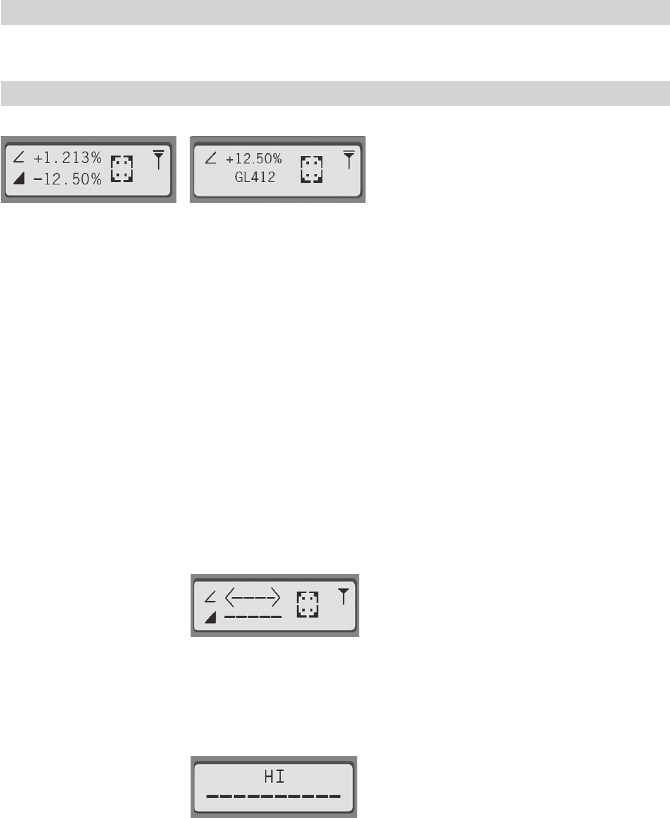
7
Laser Setup
Position the laser horizontally (tripod mount and rubber feet downward!) on a stable platform, wall mount
or tripod at the desired elevation.
The laser recognizes automatically whether it is used horizontally or vertically when switched on.
Turning On/Off the Laser
Press the power button to turn on the laser.
The LEDs (2, 4 and 5) are turned on for 2 seconds. At the LCD, the last used grade values, the mask mode
status and the antenna symbol will be displayed.
Note: The laser always powers up in the automatic self-leveling mode with 600 rpm and the last-
entered grade.
The laser is level when the leveling indicator 4 is no longer flashing (once every second) and the grade values
at the laser’s and remote control’s LCD are not flashing.
For the first five minutes after the laser self levels, the LED 4 lights solid then flashes every four seconds
to let you know the laser is still level.
Repeatedly pressing and releasing the up and right arrow buttons simultaneously toggles the rotation speed
between 300 and 600 rpm.
Note: If the temperature changes after the laser has been turned on by more than 5 degrees C (10
degrees F) the laser will compensate for the temperature change by resetting the leveling system.
During a temperature compensation reset, the grade display flashes, rotation stops and the laser
beam turns off. When the temperature compensation reset has been finished, a new grade value
can be dialed into the unit.
Note: When the laser is set up vertically and turned on, the rotor centers in its line range automatically.
The LCD indicates line can be adjusted by using the up/down (⬔) buttons.
If the laser is positioned beyond its self-leveling range of ±9%, the manual and leveling indicators flash
simultaneously and a warning sound is emitted. Turn the unit off, reposition the laser within the self-leveling
range and turn it on again.
Note: If the laser is out of its self-leveling range and remains out of it for more than 10 minutes, it
shuts down completely.
HI alert:
After the laser has been level for more than 5 minutes, the HI (height of instrument) alert activates. If the laser
is disturbed (tripod bumped, etc.) so that when it re-levels the laser beam elevation changes by more than
3 mm (1/8 in.), the HI alert shuts down the laser and rotor, a warning sound occurs and the red LED flashes
two times per second (twice the manual-mode rate). In a HI condition, a HI and flashing dashed lines appear
at the laser’s and remote control’s LCD. To restore level, turn the laser off and on.
After the laser has re-leveled, check your initial reference elevation.
Note: The HI-alert condition can also be deleted by activating/deactivating the Standby mode with
the remote control.
In order to switch the laser off, press the power button again.
GL422 – Display GL412 – Display
061331_01_GL4X2_GB.indd 7061331_01_GL4X2_GB.indd 7 06.11.2006 9:02:41 Uhr06.11.2006 9:02:41 Uhr

8
Turning On/Off the Radio Remote Control
The radio remote control is a hand-held device that allows you to send operational commands to the laser from
a remote location. A “T” appears in the right corner of the laser’s and remote’s first display line indicating a
connection between the laser and the remote control has been made. A flashing “T” indicates that the connection
has been interrupted, e.g. the operating range has been exceeded. When the radio remote control and laser
are communicating, a bar above the “T” (antenna icon) appears.
Press the power button to turn on the radio remote control.
Note: When the radio remote control is initially turned on, the standard display (model number and
software version) appear for the first 3 seconds, then the axes symbols and last-entered grade for
each axis briefly appear in the LCD. If the connection between the laser and remote is interrupted for
more than 3 seconds, the standard display appears again until the connection is re-established.
When the remote control is initially turned on and after every button press, the LCD backlight is activated and
turns off automatically if no button is pressed for 8 seconds.
The LED (2) indicates the remote control’s battery status (similar function as the battery LED at the laser).
To turn off the radio remote control, press and release the power button.
Note: 20 minutes after the last button press, the remote control turns off automatically.
Matching the remote control with the transmitter
In order to make sure the remote control can communicate with the transmitter, both units have to be matched.
First, make sure the transmitter and the remote control are turned off. Then press and hold the right arrow
button and turn on the transmitter. Next, repeat the same steps on the remote control. Both displays show
the following information:
After one second, the last used grade values, the mask mode and the antenna symbol are displayed at both
displays to indicate the transmitter has been matched with the remote control.
Activating/Deactivating Standby Mode
Standby mode is a power-saving feature that conserves laser battery life.
Press and hold the laser’s or remote control’s manual button for 3 seconds to activate standby mode.
Note: When standby mode is activated, the laser beam, rotor, self-leveling system, and LEDs shut
down, but the HI alert remains activated.
To let you know that the laser is in standby mode, the battery LED flashes every 4 seconds and dashed lines
appear in the laser’s and remote control’s LCD.
To deactivate standby mode and restore full operation of the laser, press and hold the laser’s or remote control’s
manual button for 3 seconds.
The laser and all other functions turn on again.
Using the Manual Mode
Pressing the manual button on the laser or the remote control changes the laser from automatic
self-leveling mode to Manual mode. Manual mode is indicated by the flashing (once every second) red
LED 5 plus scrolling horizontal segments appear in the LCD.
In Manual mode (horizontal), the Y(⬔)-axis can be sloped by pressing the Up- and Down-Arrow-buttons on
Manual horizontal Manual vertical
061331_01_GL4X2_GB.indd 8061331_01_GL4X2_GB.indd 8 06.11.2006 9:02:41 Uhr06.11.2006 9:02:41 Uhr

9
the laser‘s keypad or the remote control. Additionally, the X(y)-axis can be sloped by pressing the Left- and
Right-Arrow-buttons on the laser or remote control.
In vertical mode, the up and down arrow buttons align the laser beam to the right/left side, and the left and
right arrow buttons adjust the slope of the laser beam.
To resume automatic self-leveling mode, press the manual button again.
Mask Mode
Mask Mode – permits turning off the laser beam (electronic shutters) in up to 3 lighthouse windows. Mask
Mode is used when multiple lasers are on the jobsite and they are interfering with each other’s receiver.
Regardless of a horizontal or vertical setup, the mask mode for +/-Y- or +/-X-axis is selected by pressing the
manual button in sequence with one of the arrow buttons. Pressing the up or down arrow button in sequence
with the manual button will activate/deactivate the mask mode for the + or – Y axis. To activate the mask
mode on the +Y-axis, press the up arrow button at the laser or remote control, then within <1 second press
and release the Manual button. To activate the mask mode on the -Y-axis, follow the same sequence only
start with the down arrow button.
The right or left arrow button in sequence with the manual button will activate/deactivate the mask mode for
the + or – X axis accordingly.
To indicate which side of the laser the beam has been turned off, the bars on the same side of the mask mode
symbol are turned off.
Note: The unit always powers up with the mask mode deactivated (default).
Y(⬔)- or X(y)-Axis Slope Mode
Changing the Grade Value of the Y (⬔)- and X (y)-Axes
Note: The laser automatically self-levels up to +/-9% grade from a leveled tripod.
Tilt the laser towards the up-grade direction for larger grades to make sure the laser is inside its self-leveling
range.
The grade value for both axes can be changed using two methods – standard and quick-change. The standard
method is used for entering small changes in the grade value. The quick-change method is used for setting
grade to zero and entering large changes in the grade value.
To activate the grade change mode, press and hold one of the arrow buttons; a single beep confirms the
grade change mode has been entered. The single slope laser GL412 grade value can only be changed on the
Y (⬔)-axis using the up and down arrow buttons.
Standard Method
Press and hold the up or down button for the Y (⬔)-axis and the left or right button for the X (y)-axis until the
correct grade value appears in the laser’s and remote control’s LCD.
Note: The speed of the grade value change increases with the amount of time the button is held
down.
Note: Grade values from 0 to +/-9.999% are displayed to 3 decimal places.
Grade values greater than 10% are displayed to 2 decimal places.
To reverse the sign of the Y (⬔)- or X (y)- grade, press and release the manual button quickly while in grade
change mode.
The laser will self-level to the required grade position 2 seconds after releasing the grade change arrow
button or after pressing an arrow button of the unused axis; a single beep confirms the grade change mode
has been left.
Note: The grade values at the laser’s and remote control’s LCD will flash until the laser has been
self-leveled to the requested grade position.
Quick-Change Method
Note: The grade value can be quickly set to 0.000% by simultaneously pressing and holding the
arrow buttons for the axis you want to change
1. Simultaneously press and hold the up and down buttons for the Y-axis or the left and right buttons for the
X-axis to set the grade value to 0.000%.
2. Continuing to press and hold the up and down / left and right buttons will change grade in 1% increments.
061331_01_GL4X2_GB.indd 9061331_01_GL4X2_GB.indd 9 06.11.2006 9:02:42 Uhr06.11.2006 9:02:42 Uhr
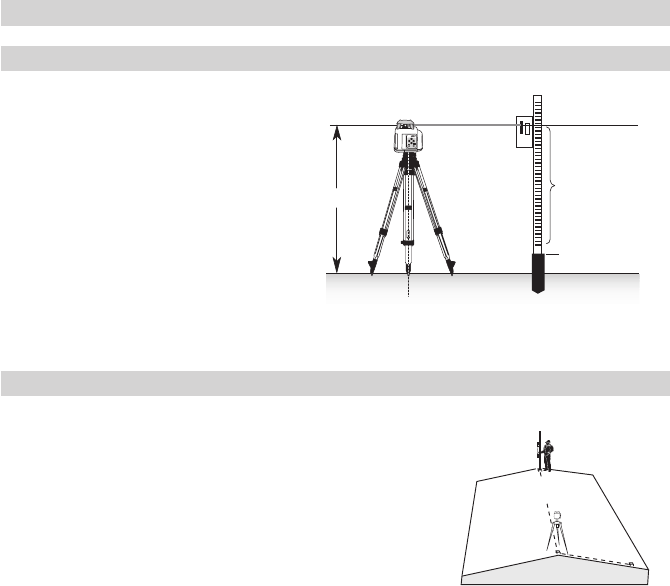
10
Note: The grade value for both axes increases in 1.00% increments. When the grade value for
either axis reaches its highest amount, the grade value switches to the lowest value for that axis.
For example, the value switches from +15% to -10%.
The laser will self-level to the required grade position, 2 seconds after releasing the grade change arrow button or
after pressing an arrow button of the unused axis; a single beep confirms the unit left the grade entry mode.
Note: The grade values at the laser’s and remote control’s LCD will flash until the laser has been
self-leveled to the requested grade position.
APPLICATIONS
General Construction
Determining the Height of Instrument (HI)
The height of instrument (HI) is the elevation of
the laser’s beam.
The HI is determined by adding the grade-rod
reading to a benchmark or known elevation.
1. Set up the laser and place the grade rod on a
job-site benchmark (BM) or known elevation.
2. Slide the receiver up/down the grade rod until
it shows an on-grade reading.
3. Add the grade-rod reading to the benchmark to
determine the height of instrument.
Example:
Benchmark = 30.55 m (100.23 ft)
Rod reading = +1.32 m (+4.34 ft)
Height of instrument = 31.87 m (104.57 ft)
Use this HI as a reference for all other elevations.
Using the Slope Mode
1. Set up the laser over the reference point (A).
2. Use the sighting guides on the top of the laser to align the laser
to the desired direction hub. Turn the laser on the tripod until it is
properly aligned.
3. Attach a receiver to a grade rod. Set the grade rod on the direction
hub (B) with the grade value 0% on both axes to check the laser’s
elevation.
Note: Use this HI as a reference for checking the alignment
of the laser after setting the slope.
4. Dial in a slope for the cross (y) axis by pressing the laser’s or remote
control’s left or right arrow button.
5. Recheck the laser’s elevation using the HI in step 3 on the 0% axis
at point (B).
Note: If the HI has been changed, rotate the laser on the tripod until you get an on-grade reading
again. Make sure you DON’T change the height of the receiver on the grade rod.
6. Dial in the final required grade value on one or both axes.
Note: Axis alignment over a short distance can be done by using only the sighting guides on the
sunshade which allows the user to skip points 3 to 5.
Note: After you’ve finished grading on one side of the road, you can reverse the sign of the y axis
using the radio remote control.
To reverse the sign of the Y (⬔)- or X (y)- grade, press and release the manual button quickly while in grade
change mode.
HI
HI = Rod Reading + Benchmark
HI = 1.32 m + 30.55 m = 31.87 m (4.34 ft + 100.23 ft = 104.57 ft)
Height of Instrument (HI)
Rod Reading
1.32 m (4.34 ft)
Benchmark
30.55 m (100.23 ft)
C
L
AC
B
061331_01_GL4X2_GB.indd 10061331_01_GL4X2_GB.indd 10 06.11.2006 9:02:42 Uhr06.11.2006 9:02:42 Uhr
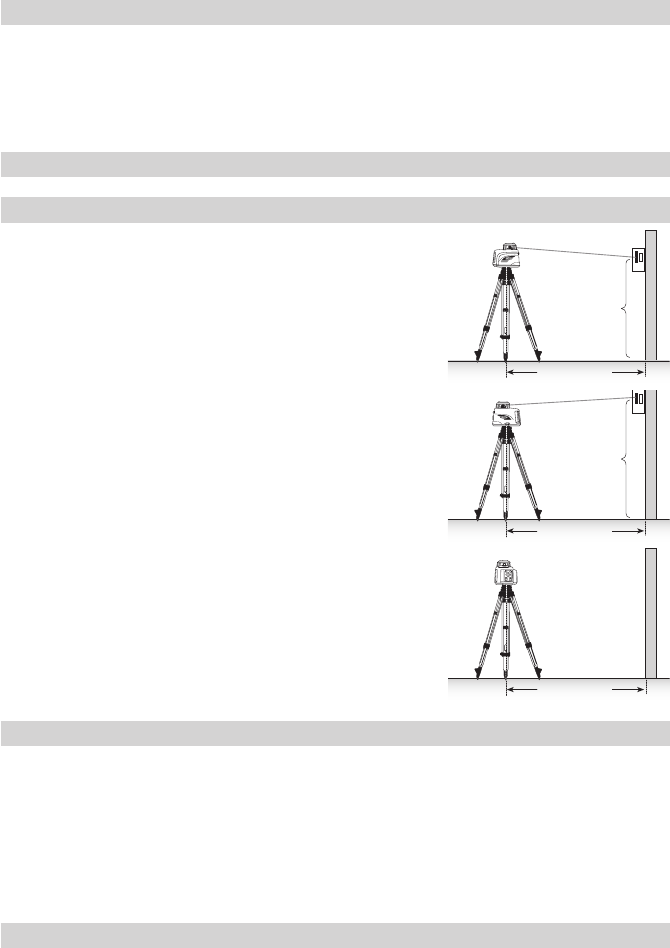
11
Establishing Vertical Alignment
1. Set up the laser on its side over the first reference point.
2. Position the receiver at the second reference point.
3. To adjust the laser beam for line direction, use the up and down buttons on the laser or radio remote control
until the laser beam matches the line point.
Note: To adjust the vertical laser beam different to the plumb position, press and release the manual
button and then use the left and right buttons on the laser or the radio remote control.
CALIBRATION
Checking Calibration of the Y- and X-Axes
1. Set up the laser 30 m (100 ft) from a wall and allow it to level.
2. Set the grade to 0.000% in both axes.
3. Raise/lower the receiver until you get an on-grade reading for the
+Y axis. Using the on-grade marking notch as a reference, make
a mark on the wall.
Note: For increased precision, use the fine-sensitivity
setting (1.5 mm/ 1/16 in.) on the receiver.
4. Rotate the laser 180° (-Y axis toward the wall) and allow the laser
to re-level.
5. Raise/lower the receiver until you get an on-grade reading for the
–Y⬔axis. Using the on-grade marking notch as a reference, make
a mark on the wall.
6. Measure the difference between the two marks. If they differ
more than 3 mm at 30 m (1/8 inch at 100 feet), the laser needs
calibrating.
7. After checking the Y-axis, rotate the laser 90°. Repeat the above
starting with the + X axis facing the wall.
Checking Calibration of the Z-(vertical) Axis
To check vertical calibration, you need a plumb bob with at least 10m (30ft) of string.
1. Suspend the plumb bob in front of a house i.e., attached to a window frame whose window height is at least
10m (30ft).
2. Set up the laser in vertical so that the laser beam strikes the receiver’s on-grade position at the top of the
string.
3. Look for any deviation using the receiver from the top of the string to the bottom of it. If the deviation is
more than 1mm (<1/16 in.), the vertical axis needs calibrating.
Note: If calibration is required, please, refer to the calibration instructions on our Trimble website
www.trimble.com/support.shtml.
PROTECTING THE UNIT
Do not expose the unit to extreme temperatures or temperature changes (do not leave inside the car).
The unit is very robust and can resist damage if dropped even from tripod height. Before continuing your work,
always check the leveling accuracy. See Checking Calibration section.
The laser is water proof and can be used indoors and outdoors.
30 m (100 ft)
x +
30 m (100 ft)
-Y
Y2
30 m (100 ft)
Y1
Y+
061331_01_GL4X2_GB.indd 11061331_01_GL4X2_GB.indd 11 06.11.2006 9:02:43 Uhr06.11.2006 9:02:43 Uhr
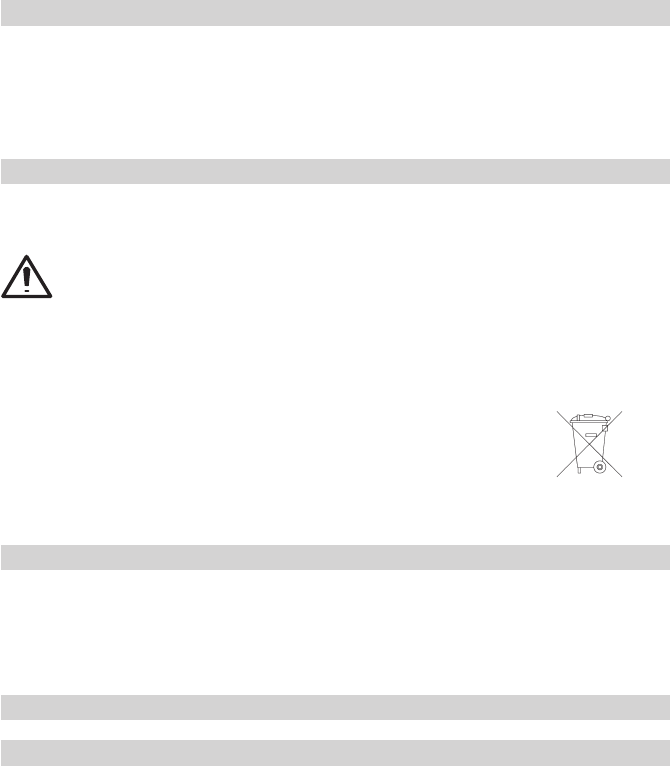
12
CLEANING AND MAINTENANCE
Dirt and water on the glass parts of laser or prism will influence beam quality and operating range
considerably.
Clean with cotton swabs.
Remove dirt on the housing with a lint-free, warm, wet and smooth cloth. Do not use harsh cleansers or
solvents.
Allow the unit to air dry after cleaning it.
PROTECTING THE ENVIRONMENT
The unit, accessories and packaging ought to be recycled.
This manual is made of non-chlorine recycling paper.
All plastic parts are marked for recycling according to material type.
Do not throw used batteries into the garbage, water or fire. Remove them in compliance with
environmental requirements.
Notice to Our European Union Customers
For product recycling instructions and more information, please go to:
www.trimble.com/environment/summary.html
Recycling in Europe: To recycle Trimble WEEE,
Call +31 497 53 2430, and ask for the “WEEE Associate”
Or
Mail a request for recycling instructions to:
Trimble Europe BV
c/o Menlo Worldwide Logistics
Meerheide 45
5521 DZ Eersel, NL
WARRANTY
According to legal regulations, the warranty-period for this unit is 12 months for material and manufacturing
defaults.
We do not take any liability for damages caused by a non-accurate unit.
Before starting to work, always carry out the Accuracy Check according to the corresponding chapter.
This warranty is no longer valid if the unit is opened or the labels are removed.
TECHNICAL DATA
Laser
Leveling accuracy1,3: ± 0.5 mm/10 m, 1/16“ @ 100 ft, 10 arc seconds
Grade accuracy 1,3: ± 1.0 mm/10 m, 1/8“ @ 100 ft, 20 arc seconds
at grades from -2.5 to +2.5%,
± 3.0 mm/10m (3/8” @ 100 ft), 60 arc seconds
at grades over +/- 2.5%.
Rotation: 600 (300) rpm
Operational area GL422 1,2: appr. 400 m (1300 feet) radius with detector
Operational area GL412 1,2: appr. 300 m (1000 feet) radius with detector
Laser type: red diode laser 635 nm – GL422; 650 nm – GL412
Laser class GL422 /GL412: Class 3A/3R, <5mW / Class 2, <3.4mW; t <0.25 sec
Self-leveling range: appr. ± 5°
Grade range GL422: -10% to +15% both axes (not simultaneously)
Grade range GL412: -10% to +15% Y(⬔)-axis
Leveling time: appr. 30 sec
Leveling indicators: LED flashes
061331_01_GL4X2_GB.indd 12061331_01_GL4X2_GB.indd 12 06.11.2006 9:02:44 Uhr06.11.2006 9:02:44 Uhr

13
Laser beam diameter1: appr. 8 mm
Operating range using remote control: up to 100 m (330 ft)
Power source: 4 x 1.5V D - cell (LR20)
Battery life1: 55 hrs NiMH; 90 alkaline
Operating temp.: -20°C to 50°C (-4°F to 122°F)
Storage temp.: -20°C to 70°C (-4°F to 158°F)
Tripod attachments: 5/8 x 11 horizontally and vertically
Dust and Water proof IP66
Weight: 3.1 kg (6.8 lbs)
Low voltage indication: flashing/shining of the battery indicator
Low voltage disconnection: unit shuts off
1) at 21° Celsius
2) under optimal atmospheric circumstances
3) along the axis
Remote control
Operating range: up to 100 m (330 ft)
Power source: 2 x 1.5V AA alkaline batteries
Battery life 1: 130 hours
Dust and Water proof IP54
Weight: 0.18 kg (0.4 lbs)
DECLARATION OF CONFORMITY
We
Trimble Kaiserslautern GmbH
declare under our sole responsibility that the products
GL422/412
to which this declaration relates is in conformity with the following standards
EN 61000-4-2, 2001; EN 55011, 2003; EN 61000-4-3, 2003
following the provisions of directive Electromagnetic compatibility 89/336/EEC.
The managing director
Electro-Magnetic Compatibility
Declaration of Conformity
This digital apparatus does not exceed the Class B Limits for radio noise for digital apparatus set out in the
Radio Interference Regulations of the Canadian Department of Communications.
This device complies with part 15 off the FCC rules. Operation is subject to the condition that this device does
not cause harmful interference.
Note: The product been tested and found to comply with the limits for a Class B digital device,
pursuant to part 15 of the FCC rules. These limits are designed to provide reasonable protection
against harmful interference in a residential installation. The product generates, uses and can
radiate radio frequency energy and, if not installed and used in accordance with the instructions,
may cause harmful interference to radio or television reception, which can be determined by turning
the product off and on. The user is encouraged to try to eliminate the interference by one or more
of the following measures:
• Reorient or relocate the receiving antenna.
• Increase the separation between the product and the receiver.
• For more information, consult your dealer or an experienced radio/television technician.
Caution: Changes or modifications to the product that are not expressly approved by Trimble could
void authority to use the equipment.
061331_01_GL4X2_GB.indd 13061331_01_GL4X2_GB.indd 13 06.11.2006 9:02:44 Uhr06.11.2006 9:02:44 Uhr